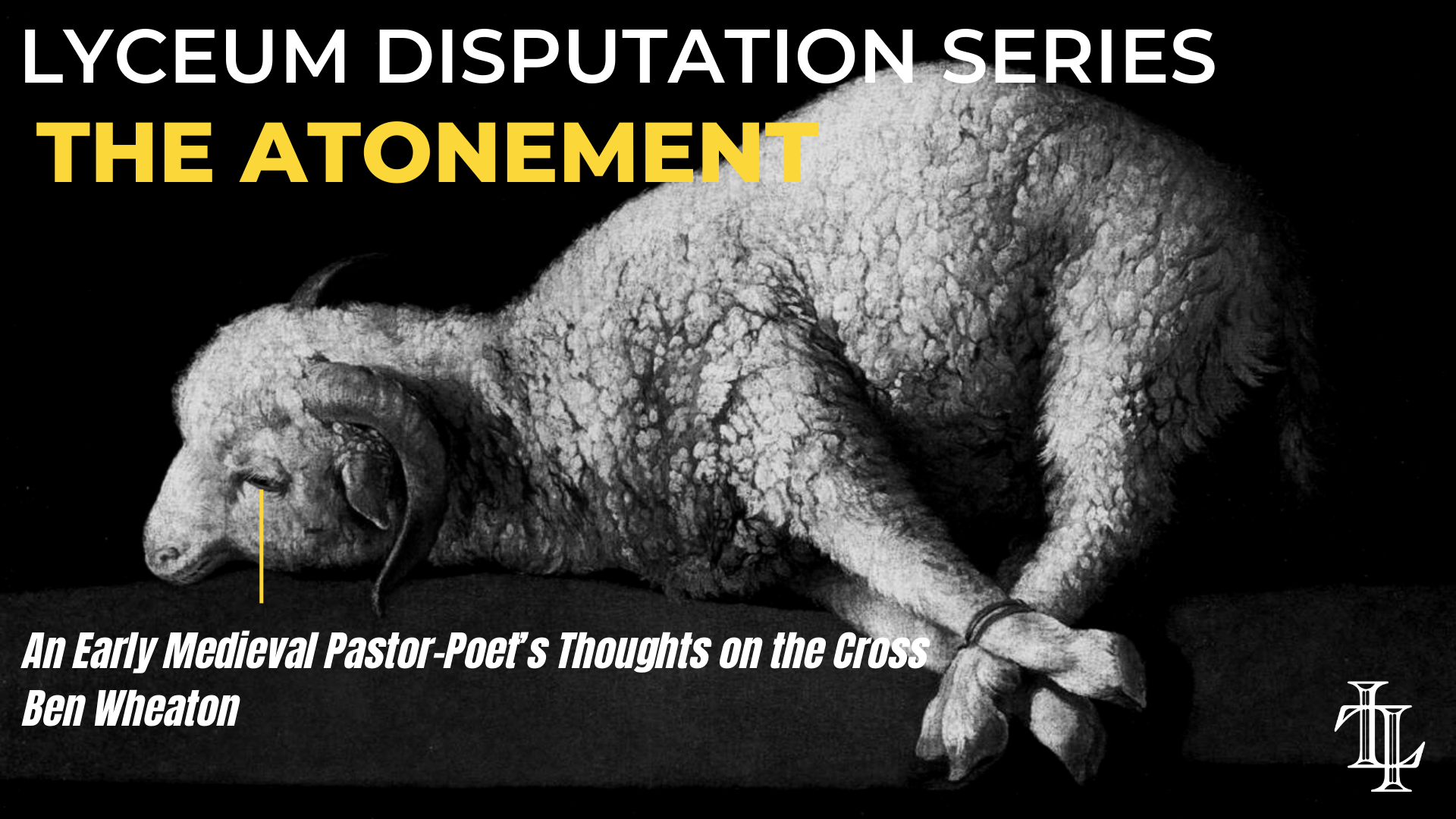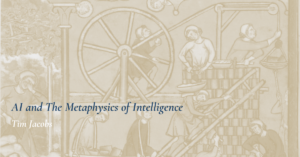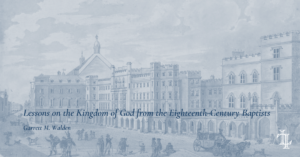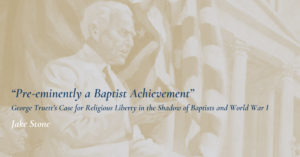Editor’s Note: This is part 5 in our Lyceum Disputation series considering the necessity of Penal Substitutionary Atonement as described in this 2017 SBC resolution. Stay tuned for further installments. As with all our work, the London Lyceum publishes a range of viewpoints to encourage thinking.
It is strange that the SBC resolution “On the necessity of penal substitutionary atonement” should make only a brief nod to the historical pedigree of this doctrine of the faith. If this understanding of the atonement is as central as is claimed, one would expect Christians from many eras to recognize this in one way or another. After all, one of the principal objections to penal substitution is that of its supposed novelty. Yet the only mention of history is: “The denial of penal substitutionary atonement necessarily compromises the biblical and historical doctrines of propitiation, expiation, ransom, satisfaction, Christus Victor, Christus Exemplar, and more.”
This is a short resolution, of course, so we should not expect too many historical claims. But the blitheness with which it skirts over the historical issues is an all too common approach to promoting penal substitution. What is worse, when the history of the atonement is scanned, promoters of penal substitution tend to cherry pick quotes from the church fathers or medieval theologians that cannot carry the semantic freight they are claimed to bear. Opponents of penal substitution capitalize on this weakness, pointing out (correctly) that sacrificial language has a broad range of meanings—although they, too, tend to cherry-pick their sources. And both sides are in any case imprisoned by the straitjacket of the popular narrative of the history of “atonement theories” popularized by Gustav Aulén: that a “demonocentic” rather than a “theocentric” focus dominated the theology of the first 1000 years of church history. In other words, the crucifixion was a means of defeating the forces of evil, death and the devil, more than it was a place where our sins against God were enabled to be forgiven. This is an untrue narrative, I believe, that needs to be buried once and for all.[1]
For the Middle Ages the centre of the atonement was Christ’s death on the cross as a sacrifice of propitiation and expiation made by God to God, reconciling humanity to God and God to humanity. If we take this as the core, we may well find the vast majority of the key elements of penal substitution bubbling up all over the place. But the SBC resolution on penal substitution makes the error of reversing the priority of the doctrine of the atonement: propitiation and expiation give rise to penal substitution and the other “theories,” and do not exhaust their meaning in any one of them, not the other way around. I would like to present a case study illustrating these points: the theology of the crucifixion of the sixth-century poet and bishop of Poitiers, Venantius Fortunatus.[2]
Such an obscure figure requires some introduction. Born between 530 and 540 AD in northeastern Italy, Venantius Fortunatus was educated in the liberal arts in the city of Ravenna, at that time under the control of the Eastern Roman Empire. He specialized in writing poetry, and in hopes of finding wealthier patrons he left Italy for Gaul (roughly modern France) in 565. Gaul was at this time ruled by the Frankish Merovingian dynasty, and in addition to inheriting a Romanized populace and tax system from the collapsed Roman Empire they inherited a taste for Latin literature. Fortunatus eventually settled in Poitiers, where he formed a close friendship with Radegund of Poitiers, founder of a famous convent, as well as with bishop Gregory of Tours. He was ordained as bishop of Poitiers in the 590s and died shortly after 600. He left an extraordinarily large body of written work to posterity, consisting of both secular and religious poetry, hymns, prose hagiographies and personal letters in both prose and poetry. He also wrote two sermons, on the Apostles’ Creed and the Lord’s Prayer, that probably date from this time of his bishopric.
The three most famous productions of Fortunatus are his hymns Pange lingua and Vexilla regis, on the cross, and Salve, festa dies, on the resurrection. The first two entered into the liturgy for Good Friday, and so appear in the hymnals of the more liturgical Protestant churches such as the Anglicans and Lutherans. The Pange lingua most typically appears in English in a nineteenth-century translation as “See the Destined Day Arise,” while Vexilla regis is usually entitled “The Royal Banners Forward Go,” also in a nineteenth-century translation. The Salve, festa dies appears in English as “Welcome, Happy Morning.” Both “See the Destined Day Arise” and “Welcome, Happy Morning” have received modern updates and are occasionally sung in evangelical churches.
I mention these hymns because “See the Destined Day Arise” has been used by a couple of evangelical writers to argue that penal substitution existed prior to the Reformation, a use that is an excellent example of mistaken cherry-picking. In an article for the Gospel Coalition in 2019, arguing for penal substitution, Daniel Hames mentioned a verse from “See the Destined Day Arise” as an example of the doctrine in history:
See the destined day arise! See a willing sacrifice!
Jesus, to redeem our loss, hangs upon the shameful cross;
Jesus, who but you could bear wrath so great and justice fair?
Every pang and bitter throe, finishing your life of woe?[3]
Matt Smethurst in a Twitter post from 2017 took note of the same passage, stating: “If you think penal substitutionary atonement is a recent invention, Venantius Fortunatus (AD 530-607) would beg to differ.”[4] But there is a problem: this is not a translation of the Pange lingua, but an adaptation of an adaptation. The verse is a concoction first of Matthew Merker, who adapted an older hymn for Sovereign Grace Music; then of Richard Mant in 1837. Mant’s version runs as follows:
See the destined day arise! See a willing sacrifice!
Jesus, to redeem our loss, Hangs upon the shameful Cross.
Jesus, who but Thou had borne, Lifted on that Tree of scorn,
Every pang and bitter throe, Finishing Thy life of woe?
Who but Thou had dared to drain Steeped in gall the cup of pain,
And with tender body bear Thorns, and nails, piercing spear?
Thence the cleansing water flowed, Mingled from Thy Side with blood;
Sign to all attesting eyes Of the finished Sacrifice.
Holy Jesus, grant us peace In that Sacrifice to place
All our trust for life renewed, Pardoned sin, and promised good.[5]
The Sovereign Grace version compresses this hymn and alters it slightly:
See the destined day arise! See a willing sacrifice!
Jesus, to redeem our loss, Hangs upon the shameful cross;
Jesus, who but You could bear Wrath so great and justice fair?
Every pang and bitter throe, Finishing Your life of woe?
Who but Christ had dared to drain, Steeped in gall, the cup of pain
And with tender body bear Thorns and nails and piercing spear?
Slain for us, the water flowed, Mingled from Your side with blood;
Sign to all attesting eyes Of the finished sacrifice.
Holy Jesus, grant us grace In that sacrifice to place
All our trust for life renewed, Pardoned sin, and promised good.
Grant us grace to sing Your praise ‘Round Your throne through endless days,
Ever with the sons of light: “Blessing, honor, glory, might!”[6]
The part of this hymn that is supposed to represent an expression of penal substitution is “Jesus, who but you could bear wrath so great and justice fair?” But this Sovereign Grace version makes penal substitution clearer than the original Mant text: “See the destined day arise! See a willing sacrifice! Jesus, to redeem our loss, hangs upon the shameful Cross. Jesus, who but Thou had borne, lifted on that Tree of scorn, every pang and bitter throe, finishing Thy life of woe?” But this is all trivial: Mant certainly held to penal substitution, and one can see glimmers of it in his version even if it isn’t as obvious as in Merker’s version. The real question is: did Fortunatus hold to penal substitution, and is this evident in the original Pange lingua?
The Pange lingua was written in 569 AD for the formal entrance into Poitiers of a relic of the True Cross, to be installed in the convent founded by Radegund, the ex-wife of the Merovingian king Chlothar I. It runs as follows (in the prose translation of Michael Roberts):
Sing, my tongue, of the battle in the famous contest and tell of the trophy of the cross and of its glorious triumph, how the redeemer of the world, though sacrificed, was yet victorious.
The Creator, grieving for the crime of our first-formed father, when by the bite of the fatal fruit he fell in death, then picked out wood to remedy the harm that wood had caused. The plan of our salvation had demanded that this take place, so that by his art he should foil the art of the shape-shifting destroyer, and secure healing from the very source from which our enemy had worked harm.
When, then, the fullness of sacred time arrived, the son, the world’s creator, was sent from his father’s heaven and incarnate in human flesh, came forth from a virgin’s womb. He cried, a baby, cradled in the confines of a manger; his virgin mother wrapped his limbs in swaddling clothes, and bands drawn tight adorend his feet, hand, and legs.
But after the passing of thirty years, the term of his life in the flesh, of his own free will, born for this purpose, surrendered to the Passion; he was raised up, a lamb for sacrifice, on the tree trunk of the cross. Here were vinegar, gall, a reed, and spittle, nails, a spear; his gentle body was pierced; blood and water flowed, by whose flood are cleansed the earth, sea, stars, the world.
Faithful cross, supremely noble tree above all others, no forest produces your like in flower, fruit, and foliage, sweet wood with sweet nails holding up a sweet burden. Flex your branches, lofty tree, relax your tight-stretched flesh, and let the hardness native to you assume a softness, to extend on gentle trunk the limbs of the heavenly king.
You alone were worthy to bear the ransom of the earth and as sailor prepare a harbor for the shipwrecked world, whom the sacred blood anointed, shed from the body of the lamb.[7]
There are many things to say about this fascinating hymn, but what concerns us for the moment is that there is no trace of penal substitution in it. Instead, what we find is an evocation of the cross as a place of triumph over the devil, as a recapitulation of the fall that reversed the fall, and as an altar of sacrifice that cleansed the world from sin. Richard Mant paraphrased quite freely. So what did the poet from the sixth century really think about the atonement? What, for him, did the cross do?
It is the last aspect of the cross mentioned above, as an altar upon which the sacrifice that enabled our sins to be forgiven was made, that is perhaps the area on which we should place our attention, rather than trying to pluck penal substitution out of the ether. The Pange lingua is focused on the cross itself, as an object, which is understandable given its provenance as a celebration of a relic. Fortunatus was deeply interested in the symbolism of the cross, and conceived of the atonement in some sense as an act of efficacious symbolism: in other words, what the cross did was affected by how it appeared. To illustrate this, let us look at one of Fortunatus’ prose theological works: a sermon on the Apostles’ Creed, entitled the Expositio symboli.
Looking at a sermon rather than a hymn has the advantage of showing us what Fortunatus thought the cross did through a piece of writing that is by its nature concerned with precise theology. Genre matters when investigating theological history; a hymn by its nature is going to be less precise and more concerned with imagery than with explaining doctrine in detail. As well, its audience and purpose is different: a hymn for a ceremonial occasion, designed to impress and dazzle its listeners, will say different things than a sermon directed toward lay Christians in a catechetical context. Fortunatus most likely wrote this sermon during his episcopate at the end of his life, so what he had to say thirty years after he wrote the Pange lingua to a very different audience are of considerable interest to anyone trying to find out what he thought the atonement was.
The Expositio symboli is, on the whole, a summary of Rufinus of Aquileia’s (AD 344-411) famous “Explanation of the Apostles’ Creed.” While summarizing, however, Fortunatus also inserted a number of original passages that express his own particular theological emphases. The lengthiest of these insertions is under the article Crucified under Pontius Pilate. There, Rufinus’ commentary lays its stress on the crucifixion as a triumph over death and the devil and a recapitulation of the fall; Fortunatus summarizes this, but then inserts a sui generis passage of his own on the cross. It runs as follows:
And since I will pass over many other things for brevity’s sake, let me not cause boredom if this passage in honor of the holy cross is extended by me to increase the instruction for you and celebration of it. Therefore Christ was suspended in the air to purify the earth and the stars, because not even the stars themselves in the eyes of the Lord were free from sin because of the fault of humanity, and the whole earth was defiled; or he was suspended from the cross to fulfill the words that the Creator had prophetically uttered, because he himself said “just as Moses raised up a serpent;” or he was suspended in the air to remove a conflict as a mediator by his own intervention, because there was great discord between heaven and earth, so that when he was set between heaven and earth peace between man and God would return after hatred; or because a terrible brigand was previously nailed to the cross, Christ therefore chose for himself the supreme punishment [i.e., execution] to free mankind from original sin, which was the supreme torment; or the Lord was hung on the cross so that as a merchant he should weigh in the balance the value of his body as ransom for our captivity; or he was crucified because we had died by a fruit and a tree, so that once again the cross and Christ, that is, a tree and fruit, by their very similarity should free us from death. Sweet fruit and tree![8]
There are several aspects of the cross laid out here for the congregation’s instruction. First, the location of the crucified Christ, between heaven and earth, denotes how his sacrifice cleanses the whole world from humanity’s sin against God; second, it fulfilled the prophecy of the bronze serpent that cleansed the Israelites from plague in the book of Numbers; third, Christ’s positioning between heaven and earth demonstrates his mediation between God and humanity on the cross; fourth, his placement on the cross instead of a brigand, and suffering that brigand’s torment, shows the great cost of freeing humanity from original sin, in that the supreme punishment was inflicted upon Christ in order to relieve us of our own supreme punishment; fifth, the cross was a merchant’s scales on which the price of our redemption was paid out; and sixth, the cross recapitulated the fall and so freed us. The final ecstatic exclamation, O dulce pomum arbore! reflects Fortunatus’ own great joy at contemplating the redemption.
So what is the doctrine of the atonement that this passage reflects? Is it penal substitution? No: although there are two places that hint at its foundations. Christ is nailed to the cross instead of a brigand, suffering the principale supplicium (supreme punishment) to absolve us of our principale tormentum (supreme torment). This, however, is more on the order of satisfaction or a variant of recapitulation, although certainly reflecting penal and substitutionary aspects of the atonement. Next, Christ is raised between heaven and earth to reconcile God and humanity, “between whom there had been great hatred.” This odium that Christ did away with fairly clearly reflects the propitiatory aspects of the crucifixion. So while the entire section reflects a theocentric understanding of the crucifixion, penal substitution is not its foundation. What the entirety of this passage is based on, I would argue, is Christ’s death as a sacrifice of propitiation and expiation made by God to God.
The source text of Rufinus, and Fortunatus’ summary thereof up to the quoted passage, is in parts “demonocentric:” in other words, it sees Christ’s crucifixion as the conquest of the devil.[9] Thus the cross is called a tropaeum, a trophy, of Christ’s victory—and ours. We see this image at the start of the Pange lingua as well. Yet intermixed with this image in the Pange lingua is that notion of the cross as a place of sacrifice: “The redeemer of the world, though sacrificed, was victorious.” Or better: “The redeemer of the world, sacrificed, was victorious;” immolatus is the term used, and reflects the concept of Christ as the sacrificial lamb by whose shed blood we are forgiven. In the Expositio symboli we find the same intermixing, this time by a deliberate insertion from Fortunatus himself of an original passage.
This section on the cross, with two exceptions, reflects the various aspects of a sacrifice for sin. Expiation, because Christ cleanses the world from sin in God’s sight; propitiation, because he does away with the odium between God and humanity. There is also ransom—although the sacrificial blood provides that, and there is no mention of the recipient of the ransom—and recapitulation, since the act done at the tree of death in Eden is redeemed by the tree of life on Calvary. The theocentricity of the atonement comes through clearly in this passage. Thus what might we conclude about Fortunatus’ doctrine of the atonement? It is surely significant that he adapted his source (Rufinus) in such a way as to emphasize the sacrificial and theocentric aspects of the crucifixion. While he delighted in the imagery of triumph and recapitulation, the centre for Fortunatus is sacrifice. He writes in his other great hymn the Vexilla regis: “His body pierced with nails, his arms and legs extended, to bring redemption he was sacrificed as victim here.”[10] Or in another poem on the cross, the Crux benedicta nitet, he writes: “The blessed cross shines bright, where the Lord incarnate hung and with his own blood washes clean our wounds, where gentle in his loving mercy he became a sacrifice for us and, a holy lamb, saved his sheep from the jaws of the wolf.”[11]
The SBC resolution claims: “The denial of penal substitutionary atonement necessarily compromises the biblical and historical doctrines of propitiation, expiation, ransom, satisfaction, Christus Victor, Christus Exemplar, and more.” But I would argue that the denial of the doctrines of propitiation and expiation, the two elements of sacrifice, are far more universally compromising. Fortunatus had no clear reference to penal substitution, yet his concept of sacrifice was well-developed and clearly dear to him. Where we see the elements of penal substitution arise in his sermon are elements that arise from this robust conception of sacrifice. The SBC resolution does much better when it says, in support of penal substitution: “The sacrificial system of the Old Testament culminated in the blood sacrifice of a spotless lamb on the Day of Atonement (Leviticus 16:11–19).” Or, as Fortunatus put it in his Vexilla regis:
Salve ara, salve victima,
de passionis gloria,
qua vita mortem pertulit
et morte vitam reddidit
Hail, O altar, Hail, O Victim,
For the glory of your passion,
By which life endured death
And by death restored life.
[1] I endeavour to make a start at doing so in my book Suffering, not Power: Atonement in the Middle Ages (Bellingham: Lexham Academic, 2022). Gustav Aulén, Christus Victor: An Historical Study of the Three Main Types of the Atonement (New York: MacMillan, 1931), remains depressingly dominant in its influence; a better study from the same period is Jean Rivière, Le dogme de la rédemption après saint Augustin (J. Gabalda et fils, 1930), also contained in a series of articles in Revue des sciences religieuses, vol. 9, nos. 2-4 (1929) [https://www.persee.fr/collection/rscir]; and followed up by his Le dogme de la rédemption au début du Moyen Âge (J. Vrin, 1934), also contained in a series of articles in Revue des sciences religieuses, vols. 11-13.
[2] The premier study of this figure in English is Michael Roberts, The Humblest Sparrow: The Poetry of Venantius Fortunatus (University of Michigan Press, 2009). See also Judith George, Venantius Fortunatus: A Latin Poet in Merovingian Gaul (Oxford: Clarendon Press, 1992).
[3] Daniel Hames, “3 Reasons I Changed My Mind About Penal Substitution (thegospelcoalition.org),” www.thegospelcoalition.org/article/3-reasons-changed-mind-penal-substitution (Accessed August 1, 2022).
[4] Matt Smethurst on Twitter: “If you think penal substitutionary atonement is a recent invention, Venantius Fortunatus (AD 530–607) would beg to differ. https://t.co/NdVpFNNAAN” / Twitter.
[5] See the destined day arise! | Hymnary.org
[6] https://sovereigngracemusic.org/music/songs/see-the-destined-day-arise/ (Accessed August 1, 2022)
[7] Venantius Fortunatus, Carmina 2.2, tr. Michael Roberts (Cambridge: Harvard University Press, 2017).
[8] Venantius Fortunatus, Carmina 11.1.24-27, tr. Roberts.
[9] Both Rufinus and Fortunatus also revel in the imagery of recapitulation, with the elements of the Edenic fall repeated and reversed in Christ’s passion.
[10] Fortunatus, Carmina, 2.6, tr. Roberts.
[11] Fortunatus, Carmina, 2.1, tr. Roberts.
Author
-
Benjamin Wheaton (PhD, University of Toronto) specializes in theology and society in Late Antiquity and the early Middle Ages. He is the author of Suffering, Not Power: Atonement in the Middle Ages, recently published by Lexham Press, of the forthcoming monograph Venantius Fortunatus and Gallic Christianity: Theology in the Writings of an Italian Émigré in Merovingian Gaul, from E.J. Brill, and of a number of articles on the Mediterranean world in Late Antiquity. He lives in Toronto.
View all posts



